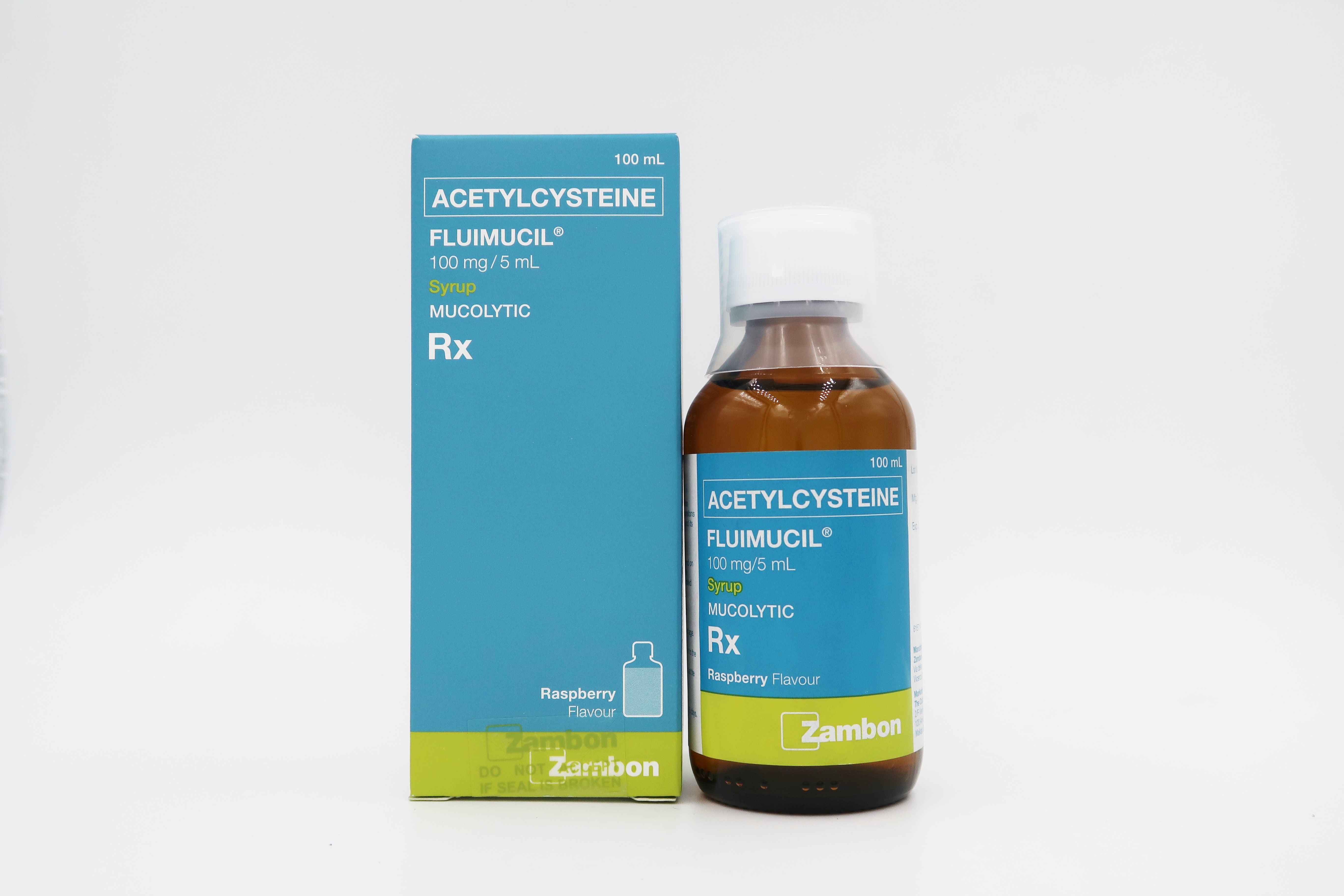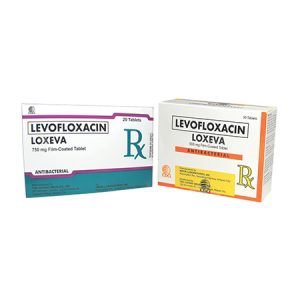Description
The Cathay Drug Co., Inc.
FORMULATION
Each 5 mL of syrup contains:
Acetylcysteine, Ph. Eur ………….. 100 mg.
PRODUCT DESCRIPTION
FLUIMUCIL SYRUP is a clear, or slightly opalescent, colorless solution with a characteristic raspberry odour.
PHARMACOLOGY
Acetylcysteine, active ingredient of FLUIMUCIL, exerts an intensive mucolytic-fluidifying action on mucous and mucopurulent secretions by depolymerizing the mucoproteic complexes and the nucleic acids which confer viscosity to the vitreous and purulent component of the sputum and other secretions.
Furthermore, acetylcysteine exerts a direct antioxidant action, having a free thiol (-SH) nucleophilic group which is able to interact directly with the electrophilic group of the oxidant radicals. Of particular interest is the recent finding that acetylcysteine protects α1-antitrypsin enzyme inhibiting elastase from the inactivation by hypochlorous acid (HOCl), a powerful oxidant agent produced by the myeloperoxidase enzyme of activated phagocytes.
These features make ACETYLCYSTEINE (FLUIMUCIL) particularly suitable for the treatment of acute and chronic affections of the respiratory system, characterized by thick, viscous mucous and mucopurulent secretions.
In addition, due to its molecular structure, acetylcysteine can easily cross the cellular membranes. Inside the cell, acetylcysteine is deacetylated to L-cysteine, an amino acid indispensable for the glutathione synthesis (GSH). GSH is a highly reactive tripeptide found ubiquitously in the various tissues of animal and is essential for the maintenance of functional capacity as well as cellular morphological integrity. It represents the most important protective endocellular mechanism against oxidant radicals, either of external or internal nature, as well as toward numerous cytotoxic substances.
Acetylcysteine plays a role of primary importance in the maintenance of adequate GSH levels contributing to the cellular protection from harmful agents which, through progressive GSH depletion, would be able to express their cytotoxic action as in the case of paractemol poisoning.
Due to this mechanism of action, acetylcysteine is also indicated as a specific antidote in paracetamol poisoning and in the course of treatment of cyclophosphamaide-induced hemorrhagic cystitis, in the latter case, it provides the –SH groups necessary to inactivate acrolein, a toxic metabolite that affects the urinary mucosae, whilst not interfering with chemotherapy.
PHARMACOKINETICS
Absorption
In humans, acetylcysteine is completely absorbed after oral administration. Because of the gut wall metabolism and first-pass effect, the bioavailability of acetylcysteine taken orally is very low (approx. 10%). No differences were reported for the various pharmaceutical forms. In patients with various respiratory or cardiac diseases, the maximum plasma concentration is obtained between two and three hours after administration and the levels remained high over a period of 24 hours.
Distribution
Acetylcysteine is distributed both in the non-metabolized (20%) and the metabolized (active)(80%) form, and can mainly be found in the liver, kidneys, lungs, and bronchial secretions. The volume of distribution of acetylcysteine rangs from 0.33 to 0.47 L/kg. Protein binding is about 50% four hours after the dose and decreases to 20% at 12 hours.
Biotransformation
Acetylcysteine undergoes rapid and extensive metabolism in the gut wall and liver following oral administration. The resulting compound, cysteine, is considered to be an active metabolite. Following this stage of transformation, acetylcysteine and cysteine share the same metabolic route.
Elimination
Renal clearance may account for about 30% of the total body clearance. Following oral administration the terminal half-life of total acetylcysteine is 6.25 (4.59 – 10.6).
INDICATIONS
Treatment of respiratory affections characterized by thick and viscous hypersecretions due to acute bronchitis, chronic bronchitis and its exacerbation, pulmonary emphysema, mucoviscidosis and bronchiectasis.
CONTRAINDICATIONS
Hypersensitivity to the ingredients of the product and to other chemically related substances or to any of the excipients.
Children below 2 years of age.
DOSAGE AND ADMINISTRATION
Adults:
10 mL of FLUIMUCIL Syrup equivalent to 200 mg acetylcysteine, 2 to 3 times daily
Children:
5 mL (1 teaspoonful) of FLUIMUCIL Syrup equivalent to 100 mg acetylcysteine, 2 to 4 times daily, according to age. The duration of treatment should be 5 to 10 days in the acute phase. It may be continued in the chronic state for several months according to the advice of the physician.
Chronic Diseases
Children, 6 to 14 years: 5 mL (1 teaspoonful) 3 times daily
Adults: 10 mL (2 teaspoonful) two times daily
Mucoviscidosis
Children, 2 to 6 years: 5 mL (1 teaspoonful) 4 times daily
Children over 6 years: 10 mL (2 teaspoonful) 3 times daily
Acute Diseases
Children, 2 to 6 years: 5 mL (1 teaspoonful) 3 times daily
Children, 6 to 14 years: 10 mL (2 teaspoonful) 2 times daily
Adults: 10 mL (2 teaspoonful) 3 times daily
Or as prescribed by the physician.
SPECIAL WARNINGS AND PRECAUTIONS FOR USE
Mucolytic agents can induce respiratory obstruction in children under 2 years of age. Due to the physiological characteristics of the airways in this age group, the ability to expectorate may be limited. Therefore, mucolytic agents should not be used in children under 2 years of age.
It is not advised to mix other drugs with Acetylcysteine (FLUIMUCIL) Syrup.
Patients suffering from bronchial asthma must be strictly monitored during the therapy. Should bronchospasm occur, the treatment must be suspended immediately and appropriate treatment must be initiated. It should be used with caution in asthmatic patients and patients with a history of peptic ulceration especially in case of concomitant administration of other medicines with a known irritating effect on the gastric mucosa.
The administration of acetylcysteine, mainly at the start of treatment, might fluidify bronchial secretion and increase their volume. If the patient is not able to effectively expectorate, postural drainage and bronchoaspiration should be performed.
Acetylcysteine may moderately affect histamine metabolism, therefore caution should be used when administrating the product for long-term therapy in patients with histamine intolerance, since symptoms of intolerance can occur (headache, vasomotor rhinitis, itching).
The possible presence of sulfurous smell is not indicative of product alterations but is a characteristic of the active ingredient contained in this preparation.
Acetylcysteine (FLUIMUCIL) Syrup contains parahydroxybenzoate which may cause allergic reactions (possibly delayed). The preparation likewise contains 0.7 mmol (or 16.6 mg) sodium per dose. This must be taken into consideration by patients on a controlled sodium diet.
USE DURING PREGNANCY AND LACTATION
Pregnancy
There is limited clinical data relating to women exposed to acetylcysteine during pregnancy. Animal studies do not suggest any direct or indirect harmful effects on the pregnancy, embryo/fetal development, birth or postnatal development.
As a precautionary measure, it is preferable to avoid the use of Acetylcysteine (Fluimucil) during pregnancy. Prior to use in pregnancy, the potential risks should be balanced against the potential benefits.
Lactation
There is no available information on the excretion in breast milk. The product should only be used during pregnancy and lactation after the benefit/risks have been weighed up carefully.
A risk to the child cannot be excluded. A decision must be made whether to discontinue breastfeeding or to discontinue/abstain from Acetylcysteine (Fluimucil) therapy taking into account the benefit of breastfeeding for the child and the benefit of therapy of the mother.
Fertility
No data are available on the effect of acetylcysteine on human fertility. Animal studies do not indicate harmful effects with respect to fertility for humans at the recommended doses.
DRUG INTERACTIONS
Drug-drug interactions
Drug interaction studies have been performed only in adults.
Antitussive drugs and mucolytic agents like acetylcysteine should not be concurrently administered because the reduction in cough reflex could lead to accumulation of bronchial secretions.
Concurrent administration of nitroglycerin and acetylcysteine has been shown to cause significant hypotension and enhance temporal artery dilation. If concurrent nitroglycerin and acetylcysteine therapy is necessary, patients should be monitored for hypotension, which can be severe, and warned of the possibility of headaches.
Concurrent use of acetylcysteine and carbamazepine may result in subtherapeutic carbamazepine levels.
Reports of an inactivation of antibiotics resulting from acetylcysteine so far only relate to in vitro tests in which the relevant substances were mixed directly. Nevertheless, when other oral drugs or antibiotics are required, it is advisable to administer the drugs 2 hours apart from acetylcysteine. This does not relate to loracarbef.
Drug-Lab modifications
Acetylcysteine may interfere with colorimetric assay method for salicylate measurement.
Acetylcysteine may interfere with urine ketone test.
Activated charcoal may reduce the effect of acetylcysteine.
ADVERSE EVENTS
Summary of the safety profile
The most frequent adverse events associated with the oral administration of acetylcysteine are gastrointestinal in nature. Hypersensitivity reactions including anaphylactic shock, anaphylactic/anaphylactoid reaction, bronchospasm, angioedema, rash and pruritus have been reported less frequently.
Tabulated list of adverse reactions
In the table below adverse reactions are listed by system organ class and frequency (very common (>1/10), common (>1/100 to <1/10), uncommon (>1/1000 to <1/100), rare (>1/10,000 to <1/1,000), very rare (<1/10,000) and not known (cannot be estimated from the available data).
Within each frequency grouping, undesirable effects are presented in order of decreasing seriousness.
Adverse reactions reported after use of N-acetylcysteine oral formulations are shown below:
| System Organ Class | Adverse Reactions | |||
| Uncommon (>1/1,000 to <1/100) | Rare (>1/10,000 to <1/1,000) | Very Rare
(<1/10,000)
|
Unknown | |
| Immune System Disorders
|
Hypersensitivity | Anaphylactic shock, anaphylactic/anaphylactoid reaction | ||
| Nervous System disorders | Headache | |||
| Ear and labyrinth Disorders | Tinnitus | |||
| Cardiac Disorders
|
Tachycardia | |||
| Vascular disorders
|
Haemoorhage | |||
| Respiratory, thoracic and Mediastinal Disorders | Bronchospasm
Dyspnea |
|||
| Gastrointestinal Disorders
|
Vomiting, diarrhea, stomatitis, abdominal pain, nausea | Dyspepsia | ||
| Skin and subcutaneous tissue disorders | Urticarial, rash, angioedema, pruritus | |||
| General Disorders and Administration Site conditions | Pyrexia | Face oedema | ||
| Investigations | Blood pressure decreased | |||
Description of selected adverse reactions
In very rare cases, the occurrence of severe skin reactions such as Stevens-Johnson syndrome and Lyell’s syndrome has been reported in temporal connection with the administration of acetylcysteine. In most cases, at least one co-suspect drug more probably involved in triggering the reported mucocutaneous syndrome could be identified.
Seek immediate medical advice if any new changes to the skin or mucous membrane occur. Acetylcysteine must be stopped immediately.
A decrease in platelet aggregation in the presence of acetylcysteine has been confirmed by various investigations. The clinical significance has not been established.
Reporting of suspected adverse reactions
Reporting of suspected adverse reactions after authorization of the medicinal product is important. It allows continued monitoring of the benefit/risk balance of the medicinal product. Healthcare professionals are asked to report any suspected adverse reactions via the national reporting system.
OVERDOSAGE
Healthy volunteers received 11.6 g of acetylcysteine daily for three months without any serious undesirable effects. Oral doses of up to 500 mg NAC/kg bodyweight were tolerated without any symptoms of poisoning.
Symptoms
Overdose may lead to gastrointestinal symptoms such as nausea, vomiting and diarrhea.
Treatment
There are no specific antidote for acetylcysteine and treatment is symptomatic.
EFFECTS ON THE ABILITY TO DRIVE AND USE MACHINES
Acetylcysteine has no known influence on the ability to drive and use machines.
STORAGE
Store at temperatures not exceeding 25°C. The bottle, once opened, can be used for 15 days.
FORMULATION AND AVAILABILITY
FLUIMUCIL Syrup, each amber glass bottle of 100 mL Syrup contains 2 g of acetylcysteine (2%) or 100 mg of acetylcysteine per 5 mL of FLUIMUCIL Syrup.
Each 100 mL bottle of syrup is packed in individual boxes provided with a measuring cup.
KEEP OUT OF REACH OF CHILDREN.
DO NOT USE BEYOND EXPIRY DATE.
Date of revision: June 6, 2019






Reviews
There are no reviews yet.